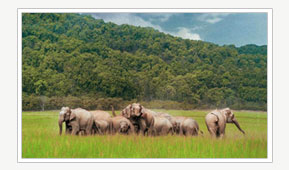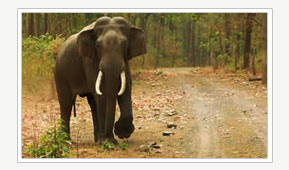 |
|
Rajaji National Park
|
|

Rajaji National Park encompasses the Shivalik range of Himalayas. It is spread over 820 sq. km. and three districts of Uttarakhand: Haridwar, Dehradun and Pauri Garhwal. In 1983, three wildlife sanctuaries in the area namely, Chilla, Motichur and Rajaji sanctuaries were merged into one forming the Rajaji National Park as we see it today.
Rajaji National Park contains tropical and subtropical moist broadleaf forests, in particular those of the Upper Gangetic Plains moist deciduous forests eco region.
The forest ecosystems of the park are quite varied and diverse. Plants such as Shorea, Mallotus, Adina, Terminalia, Bridelia, Dalbergia, Acacia, Syzygium and Phoebe are found in the park. Rajaji National Park is predominantly formed from dense green jungles, thus forms a habitat for a varied number of animals. The Park is at the northwestern limit of distribution for both elephants and tigers in India, and has the largest population of elephants in Uttarakhand. Plants such as Shorea, Mallotus, Adina, Terminalia, Bridelia, Dalbergia, Acacia, Syzygium and Phoebe are found in the park. Rajaji National Park is predominantly formed from dense green jungles, thus forms a habitat for a varied number of animals. The Park is at the northwestern limit of distribution for both elephants and tigers in India, and has the largest population of elephants in Uttarakhand.
Other wild animal species found in the Park include: Asian Elephant, Bengal Tiger, Leopard, Jungle Cat, Striped Hyena, Goral, Indian Hare, Sloth Bear, Himalayan Black Bear, King Cobra, Jackal, Barking Deer, Sambhar, Wild boar, Rhesus macaque, Indian Langur, Indian Porcupine, Monitor lizard, and Python.
315 species of birds are found in the Rajaji National Park. The most prominent avian species include pea fowl, woodpeckers, pheasants, kingfishers and barbets, supplemented by a number of migratory species during the winter months. The Park is also home to the Great Pied Hornbill, Himalayan Pied Kingfisher and the fire tailed sunbird. This area is the first staging ground after the migratory birds cross over the Himalayas into the Indian subcontinent.The rivers which flow through the Park harbour species of fish such as trout and mahseer.
|
|
 |
|